Lintneria eremitus
|
|
Updated as per The Hawk Moths of the North America, 2007, James P. Tuttle (Sphinx to Lintneria); April 2009
|
Lintneria eremitus
(Hübner, [1823]) Agrius eremitus
Hermit sphinx
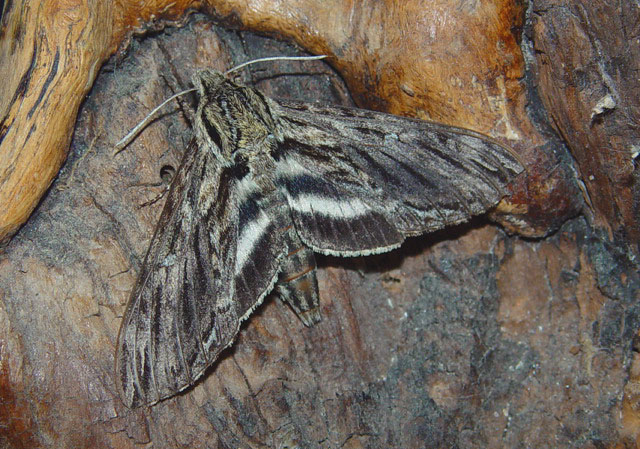
Lintneria
eremitus, June 29, 2005, Peterborough, Ontario, courtesy of
Tim Dyson.
This site has been created by
Bill Oehlke at oehlkew@islandtelecom.com
Comments, suggestions and/or additional information are welcomed by
Bill.
TAXONOMY:
Family: Sphingidae, Latreille, 1802
Subfamily: Sphinginae, Latreille, 1802
Tribe: Sphingini, Latreille, 1802
Genus: Sphinx Linnaeus, 1758 ...........
Genus: Lintneria Butler, 1876
Species: eremitus (Hübner, [1823])
|
MIDI MUSIC
.....It's a Wonderful World.....
copyright C. Odenkirk
ON.OFF
<bgsound src="world.mid" LOOP=FOREVER>
|
DISTRIBUTION:
The Hermit sphinx, Lintneria eremitus
(Wing span: 2 9/16 - 2 15/16 inches (6.5 - 7.5 cm)),
flies from Maine south to North Carolina into northern Georgia
(James K. Adams, 2002), west
to Manitoba, South Dakota and Missouri. It has been seen in
southeastern North Dakota (Gerald Fauskes).
In most of the older literature this moth is classified as
Sphinx eremitus. James P. Tuttle, in his The Hawk Moths
of North America 2007, has placed it in the Lintneria genus.
The upperside of the forewing is gray-brown with wavy lines, black
dashes, and one or two small white spots near the
center of the costa. The upperside of the hindwing is black with two
white bands and a triangular black patch at the base. Note the golden
hair on the thorax. Lintneria eremitus, June 29, 2005, Peterborough, Ontario, courtesy of
Tim Dyson.
| 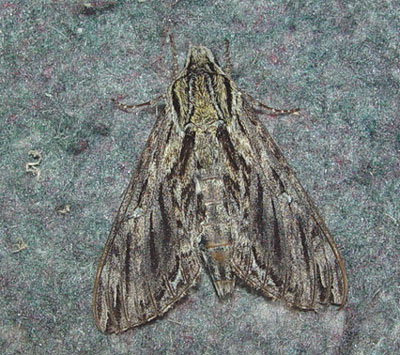 |
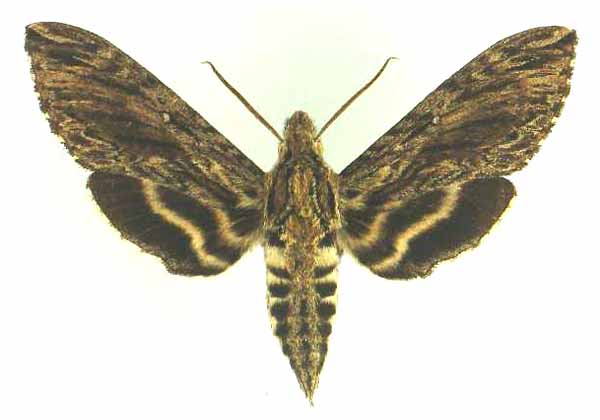
Lintneria eremitus
male courtesy of Vernon A. Brou.
FLIGHT TIMES: Lintneria eremitus
adults fly as a single brood from late June-August.
ECLOSION:Pupae probably wiggle to surface from
subterranean chambers just prior to eclosion.
Lintneria eremitus, June 29, 2005, Peterborough, Ontario, courtesy of Tim
Dyson.
| 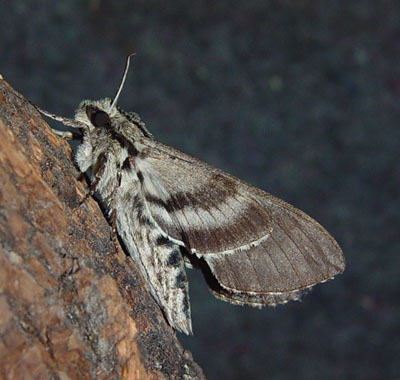 |
SCENTING AND MATING:
Females call in the males with a
pheromone released from a gland at the tip of the abdomen. Adults
nectar at deep-throated flowers including Japanese honeysuckle
(Lonicera japonica),
bouncing bet (Saponaria officinalis), petunia (Petunia
species), and catalpa (Catalpa speciosa).
David Link sends the following image of two L. eremitus nectaring
at dusk from
Asclepias syriaca (milkweed) blossoms in his yard in Door County, Wisconsin,
July 17, 2007.
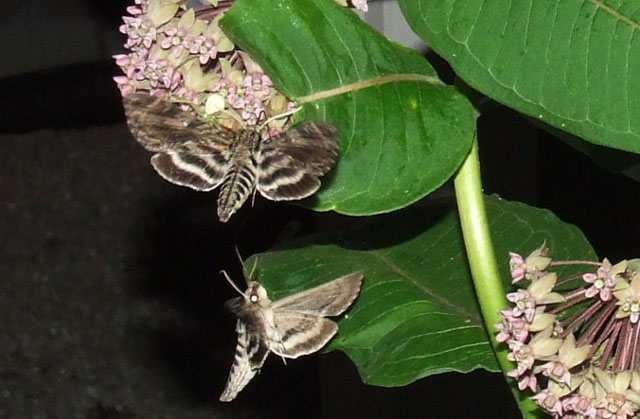
Lintneria eremitus, courtesy of David Link.
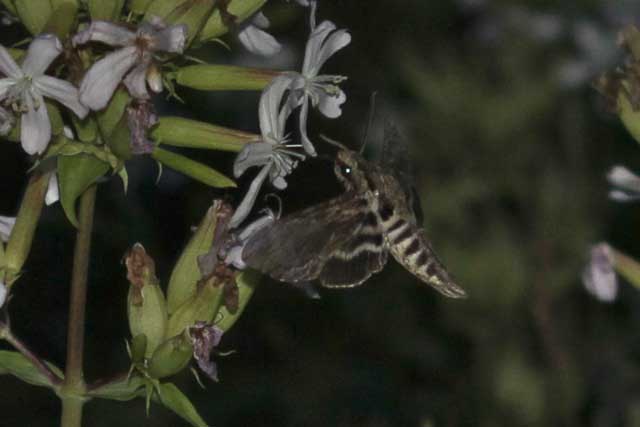
Lintneria eremitus, Ettrick, Trempealeau County, Wisconsin,
July 15, 2012, courtesy of Don Severson.
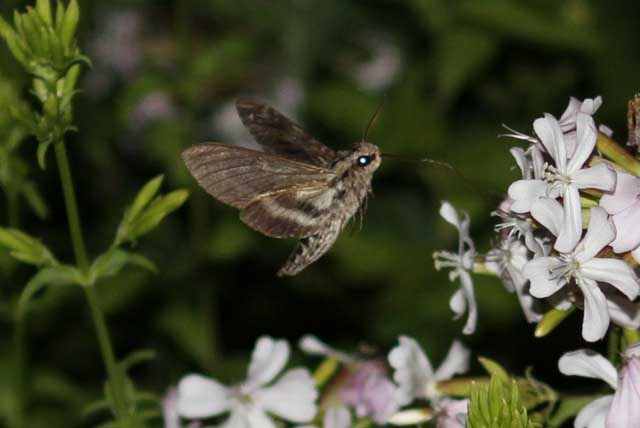
Lintneria eremitus (verso), Ettrick, Trempealeau County, Wisconsin,
July 15, 2012, courtesy of Don Severson.
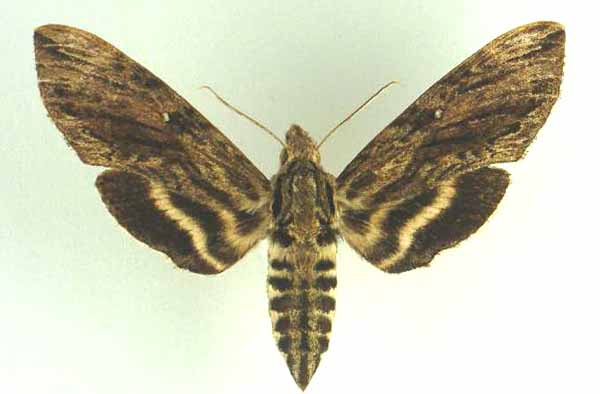
Lintneria eremitus female courtesy of Vernon A. Brou.
EGGS, LARVAE, PUPAE:
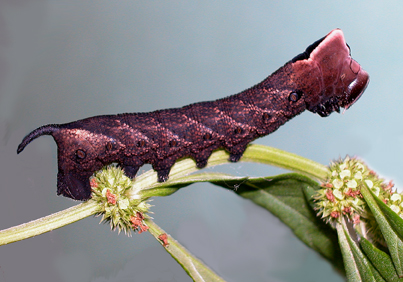 Larval hosts are various
species of beebalm
(Monarda fistulosa),
mints (Mentha), bugleweed (Lycopis), and sage
(Salvia). Image courtesy of Gerald Fauskes.
|
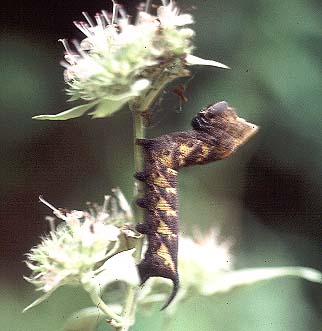
Image courtesy of Kathleen Casses, 2001. |
On August 10, 2006, Joan F. Rickert sent me
this image of an immature Sphingidae larva feeding on Monarda
in Taylor County, Wisconsin.
I am pretty sure it is Lintneria eremitus based on thoracic scoli
and foodplant, and, since Joan reports it is only about an inch long, I
suspect it is in third instar.
Congratulations to Joan on an unusual find. Hope she is able to
send additional images as the larva matures. |
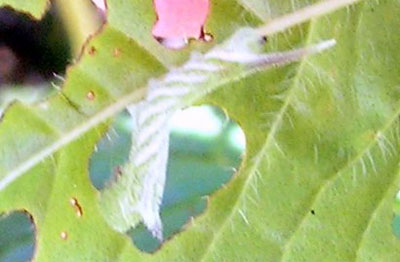 |
On August 22, 2006, Joan was able to send me a series of beautiful
images, confirming the larva above as Lintneria eremitus.
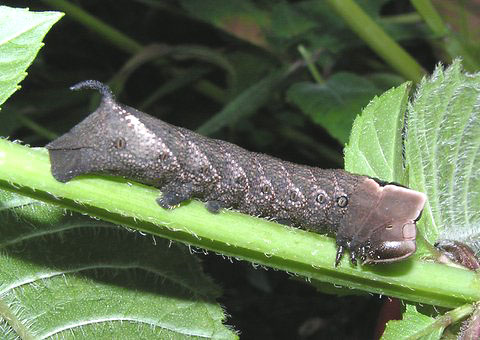
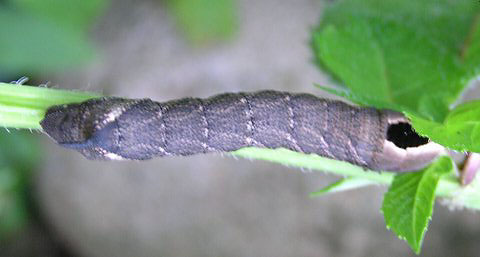
Lintneria eremitus, August 22, Taylor County, Wisconsin, courtesy
of Joan F. Rickert.
Joan writes, "The pictures of the large Hermit Sphinx
caterpillar were taken last night, August 22, in my garden on Monarda.
I was very surprised to find it - it was near the base of a plant
and not easy to see! I did not know it was there so I was happy to
find it. The smaller one is changing colors now. Do they pupate in
the ground?
I do not know if Lintneria eremitus larvae excavate a subterranean
chamber in which to pupate or if they pupate in leaf litter
on top of the ground. I suspect they tunnel.
Joe Garris of Sussex, New Jersey, reports larvae also feed on
Collinsonia canadensis (Canada Horsebalm, Richweed, Hardhack,
Heal-All, Horseweed), and he indicates "By the way, you can rear
S. eremitus on the houseplant, Coleus.
"When I was running short of fresh Collinsonia one day, it
dawned on me that Coleus is a member of the mint family
(Lamiaceae) (square stem, flowers, etc.). The caterpillars devoured it. Since my
wife had lots of Coleus growing in big pots on the deck, I
never fed them anything else after that."
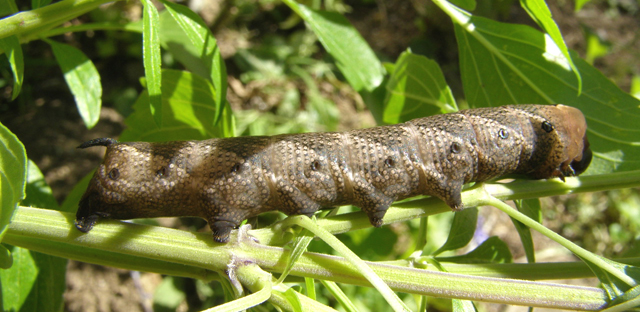
Lintneria eremitus, Northampton County, Pennsylvania, on Salvia, courtesy
of Karen Sauter.
Visit Lintneria eremitus fifth instar, Ogemaw County, Michigan, Cindy Mead.
Visit Lintneria eremitus larva, pupa and adult moth,
Door County, Wisconsin, courtesy of Janice Stiefel.
Visit Lintneria eremitus fifth instar and pupa, Apalachin, Tioga County, New York, September 22, 2008, courtesy of Colleen
Wolpert.
Visit Lntneria eremitus fifth instar, Granby, Hartford County, Connecticut,
September 20, 2009, courtesy of Krissy Craig.
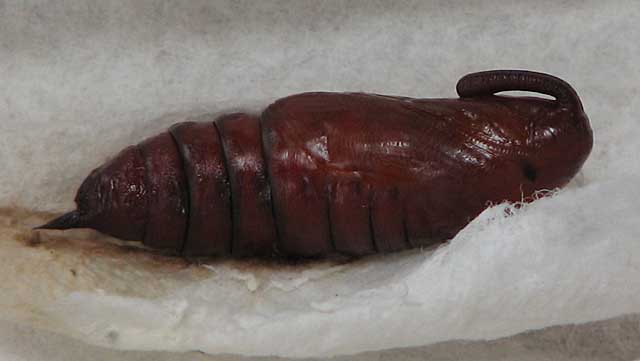
Lintneria eremitus pupa, Apalachin, Tioga County, New York,
October 8, 2008, courtesy of Colleen Wolpert.
Colleen writes, "The Hermit Sphinx caterpillar finally pupated October 8, 2008 after being in a 'crunched up' form for a couple of weeks after ceasing eating a day or two
after I found it (September 22, 2008). The pupa was originally tan and I didn't get a photo then.
Today, October 14, 2008, I took pupa out of the container as it is darker and harder now. It still wiggles when disturbed. I didn't touch it, but moved it by
dragging the paper towel it is on."
I am surprised the larva took so long to pupate. Most mature Sphingidae larvae pupate within a week after feeding stops.
Please visit my special request for images of Lintneria species larvae at
Lintneria larvae, and help if you can.
It is anticipated that the Lintneria larvae will most often be encountered on Lamiaceae: Salvia (Sage), Mentha (Mints), Monarda (Beebalm) and
Hyptis (Bushmints); Verbenaceae: Verbena and Lantana camara (shrub verbenas or lantanas).
Although they may be encountered feeding during daylight hours, one is even more likely to discover them feeding in the evening or after dark.
Two of the greatest clues for discovering larvae are stripped foliage and droppings beneath the plant. You might be quite surprised at what will turn up in the evening or
after dark in a flashlight assisted search.
It is believed that all "Lintneria larvae will exhibit "a fleshy thoracic dorsal "horn" in the first 4 instars (unique in the Sphingidae of the world to my
knowledge) which is replaced by a thoracic dorsal "hump" with a large black patch in the 5th instar." J.A. Tuttle.
Return to Sphingidae Index
Return to Sphingini Tribe
Use your browser "Back" button to return to the previous page.
This page is brought to you by
Bill Oehlke and the
WLSS. Pages are on space rented from Bizland. If you would like
to become a "Patron of the Sphingidae Site", contact Bill.
Please send sightings/images to Bill. I will do my best to respond to
requests for identification help.
Enjoy one of nature's wonderments: Live
Saturniidae (Giant Silkmoth) cocoons.
 | 
Show appreciation for this site by clicking on flashing butterfly to the left.
The link will take you to a page with links to many insect sites. |
















